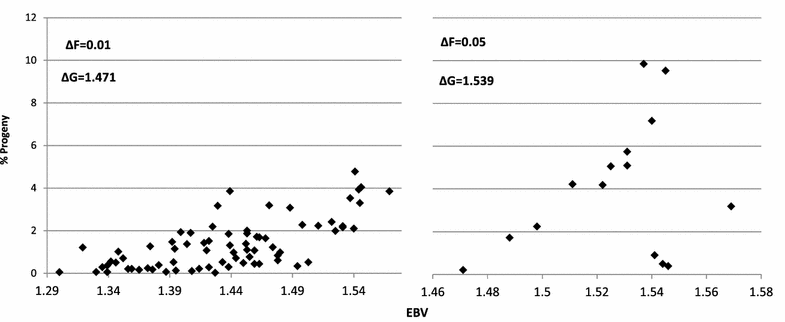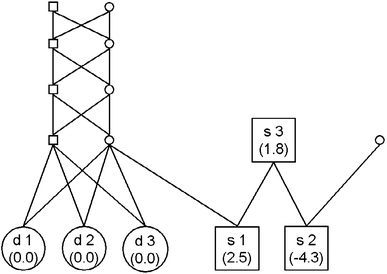A fast Newton-Raphson based iterative algorithm for large scale optimal contribution selection
- PMID: 27650044
- PMCID: PMC5030763
- DOI: 10.1186/s12711-016-0249-2
A fast Newton-Raphson based iterative algorithm for large scale optimal contribution selection
Abstract
Background: The management of genetic variation in a breeding scheme relies very much on the control of the average relationship between selected parents. Optimum contribution selection is a method that seeks the optimum way to select for genetic improvement while controlling the rate of inbreeding.
Methods: A novel iterative algorithm, Gencont2, for calculating optimum genetic contributions was developed. It was validated by comparing it with a previous program, Gencont, on three datasets that were obtained from practical breeding programs in three species (cattle, pig and sheep). The number of selection candidates was 2929, 3907 and 6875 for the pig, cattle and sheep datasets, respectively.
Results: In most cases, both algorithms selected the same candidates and led to very similar results with respect to genetic gain for the cattle and pig datasets. In cases, where the number of animals to select varied, the contributions of the additional selected candidates ranged from 0.006 to 0.08 %. The correlations between assigned contributions were very close to 1 in all cases; however, the iterative algorithm decreased the computation time considerably by 90 to 93 % (13 to 22 times faster) compared to Gencont. For the sheep dataset, only results from the iterative algorithm are reported because Gencont could not handle a large number of selection candidates.
Conclusions: Thus, the new iterative algorithm provides an interesting alternative for the practical implementation of optimal contribution selection on a large scale in order to manage inbreeding and increase the sustainability of animal breeding programs.
Figures


Similar articles
-
An algorithm to compute optimal genetic contributions in selection programs with large numbers of candidates.J Anim Sci. 2006 Dec;84(12):3212-8. doi: 10.2527/jas.2006-145. J Anim Sci. 2006. PMID: 17093213
-
Increased genetic gains in sheep, beef and dairy breeding programs from using female reproductive technologies combined with optimal contribution selection and genomic breeding values.Genet Sel Evol. 2015 Sep 14;47(1):70. doi: 10.1186/s12711-015-0151-3. Genet Sel Evol. 2015. PMID: 26370143 Free PMC article.
-
Controlling inbreeding and maximizing genetic gain using semi-definite programming with pedigree-based and genomic relationships.J Dairy Sci. 2011 Dec;94(12):6143-52. doi: 10.3168/jds.2011-4574. J Dairy Sci. 2011. PMID: 22118102
-
Animal breeding strategies can improve meat quality attributes within entire populations.Meat Sci. 2017 Oct;132:6-18. doi: 10.1016/j.meatsci.2017.04.019. Epub 2017 Apr 21. Meat Sci. 2017. PMID: 28515004 Review.
-
Integrating genomic selection into dairy cattle breeding programmes: a review.Animal. 2013 May;7(5):705-13. doi: 10.1017/S1751731112002248. Epub 2012 Dec 3. Animal. 2013. PMID: 23200196 Review.
Cited by
-
Genomic mating as sustainable breeding for Chinese indigenous Ningxiang pigs.PLoS One. 2020 Aug 14;15(8):e0236629. doi: 10.1371/journal.pone.0236629. eCollection 2020. PLoS One. 2020. PMID: 32797113 Free PMC article.
-
Management of Genetic Diversity in the Era of Genomics.Front Genet. 2020 Aug 13;11:880. doi: 10.3389/fgene.2020.00880. eCollection 2020. Front Genet. 2020. PMID: 32903415 Free PMC article.
-
Novel optimum contribution selection methods accounting for conflicting objectives in breeding programs for livestock breeds with historical migration.Genet Sel Evol. 2017 May 12;49(1):45. doi: 10.1186/s12711-017-0320-7. Genet Sel Evol. 2017. PMID: 28499352 Free PMC article.
-
Long-term impact of conventional and optimal contribution conservation methods on genetic diversity and genetic gain in local pig breeds.Heredity (Edinb). 2021 Dec;127(6):546-553. doi: 10.1038/s41437-021-00484-z. Epub 2021 Nov 8. Heredity (Edinb). 2021. PMID: 34750534 Free PMC article.
-
Selective advantage of implementing optimal contributions selection and timescales for the convergence of long-term genetic contributions.Genet Sel Evol. 2018 May 10;50(1):24. doi: 10.1186/s12711-018-0392-z. Genet Sel Evol. 2018. PMID: 29747576 Free PMC article.
References
-
- Burrow HM. The effects of inbreeding in beef cattle. Anim Breed Abstr. 1993;61:737–751.
-
- Falconer DS. Introduction to quantitative genetics. 3. Harlow: Longman Scientifics & Technical; 1989.
-
- Lamberson WR, Thomas DL. Effects of inbreeding in sheep. A review. Anim Breed Abstr. 1984;52:287–297.
-
- Grundy B, Villanueva B, Woolliams JA. Dynamic selection procedures for constrained inbreeding and their consequences for pedigree development. Genet Res. 1998;72:159–168. doi: 10.1017/S0016672398003474. - DOI
MeSH terms
LinkOut - more resources
Full Text Sources
Other Literature Sources

